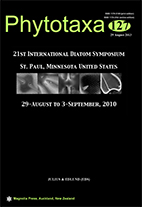Abstract
Minnesota boasts over 12,000 lakes, most of glacial origin, three major continental drainage systems (Mississippi River to the Gulf of Mexico, Lake Superior via the other Great Lakes to the Atlantic Ocean, and the Red River of the North via the Nelson River, to Hudson Bay), and a diversity of landforms comprising seven major ecological regions. Such landscape and aquatic variability hosts a high diversity of diatoms, which have been studied for over 150 years. Diatom communities range from saline and eutrophic in the southwest agricultural lands, to oligotrophic and endemic forms in the cold waters of Lake Superior. Early diatom collections were distributed to reknowned diatomists such as C.G. Ehrenberg and H.L. Smith. Other botanists and phycologists, including Tilden, Eddy, and Drouet, were active in Minnesota but only rarely included diatoms in their studies. Interest in Minnesota diatoms increased in the latter half of the 20th century with taxonomic and floristic surveys (e.g., Czarnecki, Koppen, and Kingston) and the inclusion of diatoms in applied research efforts that set the groundwork for understanding post-glacial ecology, effects of Euroamerican settlement, impacts of climate, and the effects of acid precipitation. Important to these latter developments were the efforts of Dr. Herb Wright Jr., who invited several European diatomists (e.g., Florin, Battarbee, and Haworth) to work on paleoecological projects in and near Minnesota. Although not a diatomist per se, Wright's subsequent efforts to promote diatom research included the appointment of Platt Bradbury as a research associate and later John Kingston, Dick Brugam, and Brian Cumming. Students Sheri Fritz, Kate Laird, and Virginia Card completed diatom research for their doctoral degrees. These workers and others have left a legacy that continues to fuel several active labs in Minnesota that have used diatoms to develop water quality standards, assess and restore impaired waters, and understand the impacts of climate, management, and landuse change across the state.

